Stop lifting your leg!
The former US NCAA Division 1 athlete started performing the exercise in their program, the single leg stiff leg deadlift, for the first time under my supervision.
As they bent forward their non-support leg began to lift backwards. I asked:
‘Why are you lifting your leg?’
They replied:
‘Because that is how I was taught to do it.’
I found this really ironic, as the exercise I originated the exercise from Australia, and now I had to correct it from American influence. I published this exercise in the from the late 1990s onwards [i] [ii] [iii] [iv] [v] [vi] [vii] [viii] [ix] [x] after a decade or so of testing.
I found it ironic but not surprising, as for nearly two decades now I have watched the bastardization of my innovation. I spend the most of the first decade post 2000 wondering how this ‘variation’ came about. How did my exercise end up being messed up so badly? Then I stumbled on the answer.
It was published in Men’s Health in 2000[xi], unreferenced and un-credited, by another ‘author’.
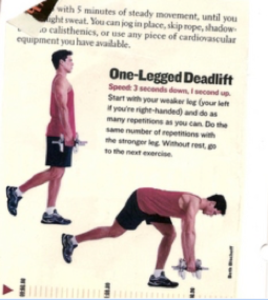
At the photo shoot I suspect the male model made up his own interpretation.
I understand how most photos shoots happen. The ‘author’ is rarely if ever on site. An unknown organizes the photo shoot, and the result in this case was an exercise where the subject lifted their back leg.
So the reason why the world now does this exercise with the back leg moving backwards is – because they are copying a misinterpretation done by a Men’s Health male model in a photo shoot!
A good enough reason? I don’t believe so….
Reminds me of the story about a trend in marathon runner. The story goes that Australia’s lead marathon runner in the 1982 Commonwealth Games was suffering from diarrhea as they ran. The solution they chose to reduce the embarrassment was to wipe their legs down with the face wipe cloths offered at regular intervals in the break. From watching this act, a new trend was developed – wipe your legs down with the wet face clothes.
Is this a good reason to wipe your legs down in a marathon? I don’t think so….(unless you find yourself with brown colored liquid bodily fluids running down your leg…)
So apart from the fact that the masses of coaches and trainers of the world are imitating a mistake, what is the problem with the exercise. Any movement is good movement, surely? Well, yes and no.
It’s great to be moving. However the general intent of an exercise is to fix one end of the muscle and move or stretch the other end. This makes the muscle work. When you lift your leg backwards, this stretch or strain intended for the hamstring is reduced because of the movement of the back leg. So you are doing an exercise with movement, but a significant reduction in the intended target muscle.
When you lift your back leg up it counterbalances the movement to the front, reducing the stretch and effort. When you go to stand up again, the lower of the leg back down does most of the work. It becomes more of a ballet like balance exercise than a strength exercise. For some that may be all they need, but please, stop masquerading it as a strength exercise!
Put simply you are doing less work.
Now I appreciate that not all can do this exercise full range due to lack of strength or flexibility or balance. However avoiding this challenge is not going to fix the limitations! Start with limited range, and place a premium on increasing the range progressively over time, rather than looking to increase load straightway. Just about every Google image of this exercise has a DB or similar in hand – don’t follow this! Most people cannot get range with their own bodyweight, so don’t add load until you have full range!!!
Just about every gym I go anywhere in the world I see this exercise being done, and it always reminds me of the oil well devices you see littered in the desert, where the lever is long and heavy to assist the oil to be pumped with less energy.

Now for the purists who remember the difference between a single joint and multi-joint movement, they know the single joint movement offers more isolation, and the multi-joint less. By moving the back leg you change the exercise from a (almost) single joint exercise to a double joint exercise.
Now I don’t expect to reverse this mistaken exercise option. It has gone too far. It’s been published without thought by too many well-marketed US ‘gurus’, especially as a key ‘functional’ exercise.
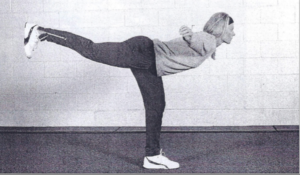
However, for those who would prefer to exercise for a reason better than copying the confusion of a male model at a US photo shoot….here is how I originally intended for you to do this exercise:
Single Leg standing Stiff Legged Deadlift: Let the fun begin! Stand on one leg – have the other foot off the ground, but kept roughly parallel with the leg doing the supporting. Bend the knee slightly, but that knee angle should not change during the exercise (get a partner to watch for this, as it will be tempting to do so!). Now bend at the waist, allowing the back to round and reach slowly towards the floor. If your range allows, touch the floor with the fingertips and return to the starting position. Use a speed of 3 seconds down, 1 sec pause at the ends, and 3 seconds up.
You may struggle with balance, but persist – you will be developing the muscles in the sole of the foot! The first time you do this you may find you are touching down with the non-supporting foot regularly to avoid falling over. This is ok, but in later workouts, try to minimize this. When you have mastered this exercise, and touching of the ground by the non-supporting leg means terminate the set – this is your challenge.
Don’t be surprised if you can only do 5 reps on day 1! Look to increase the reps from workout to workout. Hold light DB’s in your hand ONLY when you get to 10 reps at the speed indicated. No warm up set necessary. Remember the weak side rule.
Here’s what it should look like, performed by dual Olympian and Gold medalist (2000)!
The top position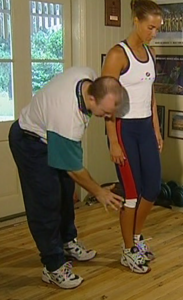
The bottom position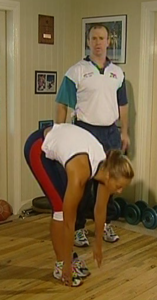
Need more clarity?
Unfortunately a few select individuals in the US thought it was okay to publish this exercise innovation without reference or credit. And created a highly marketed mis-interpretation of my exercise.
So what makes me think the ‘author’ of this Men’s Health article was ‘copying’? Maybe it was their email…
From: name withheld Sent: Saturday, 4 December 1999 5:18 AM To:kingsports@b022.aone.net.au Subject: Re: Between Sets Newsletter #6
Ian, …It’s funny ‐ I have bben doing your t‐mag leg workouts ( the first two). It seems such as hort workout a.. this is done in a half an hour. But ‐ the pain !!!!!!!!!!!! You weren’t kidding ‐ it is a deep muscle soreness ‐ real intense. Interstingly it is a great workout to introduce females to weigth lifting and training. (A lot of them are scared to lift heavy) Keep them coming… ‐name withheld
Maybe it was the way they re-publishing my content verbatim in multiple ‘publications’….[xii]
Single leg standing stiff leg deadlift: Stand on one leg – have the other foot off the ground, but kept roughly parallel with the leg doing the supporting. Bend the knee slightly, but that knee angle should not change during the exercise (get a partner to watch for this, as it will be tempting to do so!). Now bend at the waist, allowing the back to round and reach slowly towards the floor. If your range allows, touch the floor with the fingertips and return to the starting position.
The first time you do this you may find you are touching done with the non-supporting foot regularly to avoid falling over. This is ok, but in later workouts, try to minimise this. When you have mastered this exercise, touching of the ground by the non-supporting leg means terminate the set – this is your challenge.
Not even a conversion from Australian spelling to US spelling, or editing of the grammar or layout! Just a straight (one of thousands) cut and paste. So yes, the Men’s Health submission was an un-credited, unreferenced submission.
A ‘breakthrough’ in later years – same description, but a name change for the exercise![xiii] [xiv]
Single Leg Romanian Deadlift: Stand on one leg – have the other foot off the ground, but kept roughly parallel with the leg doing the supporting. Bend the knee slightly, but that knee angle should not change during the exercise (get a partner to watch for this, as it will be tempting to do so!). Now bend at the waist, allowing the back to round and reach slowly towards the floor. If your range allows, touch the floor with the fingertips and return to the starting position.
It’s tough to watch an otherwise potentially intelligent species of animal blindly follow a misinterpretation. And its tough to watch the potential of this exercise I developed over years be diluted to look like and exercise when it’s not really doing much.
So unless you think it a worthy use of your training to copy a misinterpreted Men’s Health snippet, STOP LIFTING YOUR LEG!

Returning to the NCAA athlete who received a much-needed correction in exercise interpretation, I asked:
‘So how did you feel about the exercise when you were throwing your leg back?’
To which they replied:
‘Well actually, I could feel the exercise doing anything, and I didn’t understand why I was doing it. I did ask the strength coach, but their answer just didn’t add up’.
Mmm. not surprising. At least some human beings are in touch with their intuition…
The key is this – if you have read this you have been given a chance to stop lifting your leg, hold it parallel to the other, foot just off the ground, and get a real workout – the way it was intended!
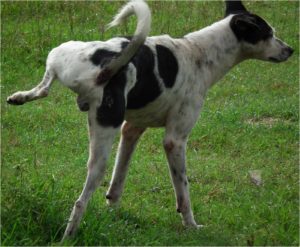
[i] King, I., 1998, Strength Specialization Series King Sports International, Brisbane, Aust. (DVD)
[ii] King, I., 1998, Strength Specialization Series, King Sports International, Brisbane. (Audio)
[iii] King, I., 1998, How To Write Strength Training Programs: A Practical Guide, King Sports Publishing, Brisbane, Aust. (Book)
[iv] King, I., 1999, Ian King’s Killer Leg Exercises, t-mag.com (DVD)
[v] King, I., 1999, 12 Weeks of Pain – Limping into October – Pt 1, t-mag.com, 17 Sep 1999. (Article)
[vi] King, I., 1999, Get Buffed!™, 1st Ed., King Sports Publishing, Bris. Aust. (Book)
[vii] King, I., 2000, How To Teach Strength Training Exercises, King Sports Publishing, Brisbane, Aust. (Book)
[viii] King, I., 2000, How To Teach Strength Training Exercises, King Sports International, Brisbane, Aust. (DVD)
[ix] King, I., 2000, Make your legs soar, Men’s Health, November, p. 28-29. (Article)
[x] King, 2001, Advanced Leg Training: Stage 1, Fri, Jan 19, 2001
[xi] Single leg deadlift, Men’s Health, June 2000
[xii] ‘Authors’ name withheld to reduce drawing attention to plagiarists, 2003, Marcocycle, CA USA
[xiii] ‘Authors’ name withheld to reduce drawing attention to plagiarists, 2005, Program Design Bible, CA USA.
[xiv] ‘Authors’ name withheld to reduce drawing attention to plagiarists, The Female Breakthrough, xxx.

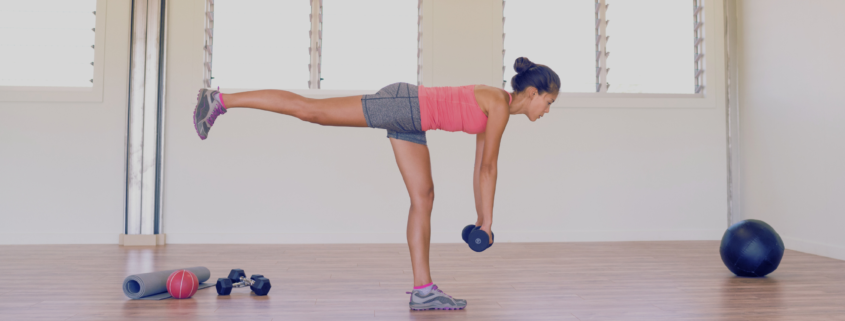


Thanks for this Ian! First saw this exercise in T Nation in your famous limping series. Did the program and learned a lot back then. Still use your first limping phase when athletes start leg training again. Some athletes and coaches in our facility use the “American” version you described. An athlete of mine asked me once why he had to do it your way, so I told him to try the other way and then give me his opinion. No need to say more. He understood. Thank you Ian!
Great to hear Carson! as a person who read the article back in 1999 you have a greeter appreciation of the history and how it’s unfolded. I too use the Limping type program with an athlete at the start of the year and career, to this day. and its great when you have, as you described, a conflicted athlete, not sure to depart from ‘what everyone else is doing’, to have them do it both ways and reach their own conclusion. this simple personal ‘experiment’ is worth so much more than left brain ‘thinking’!